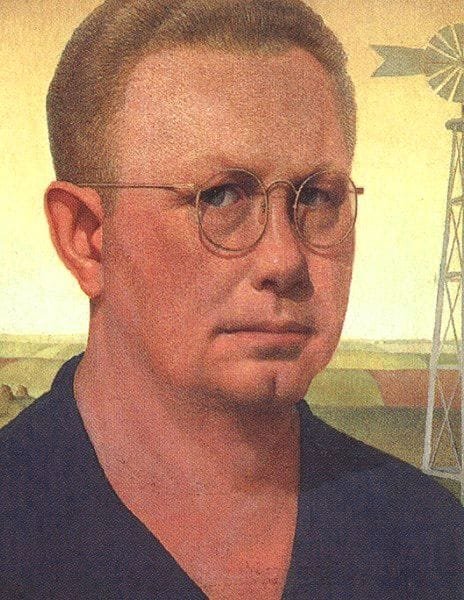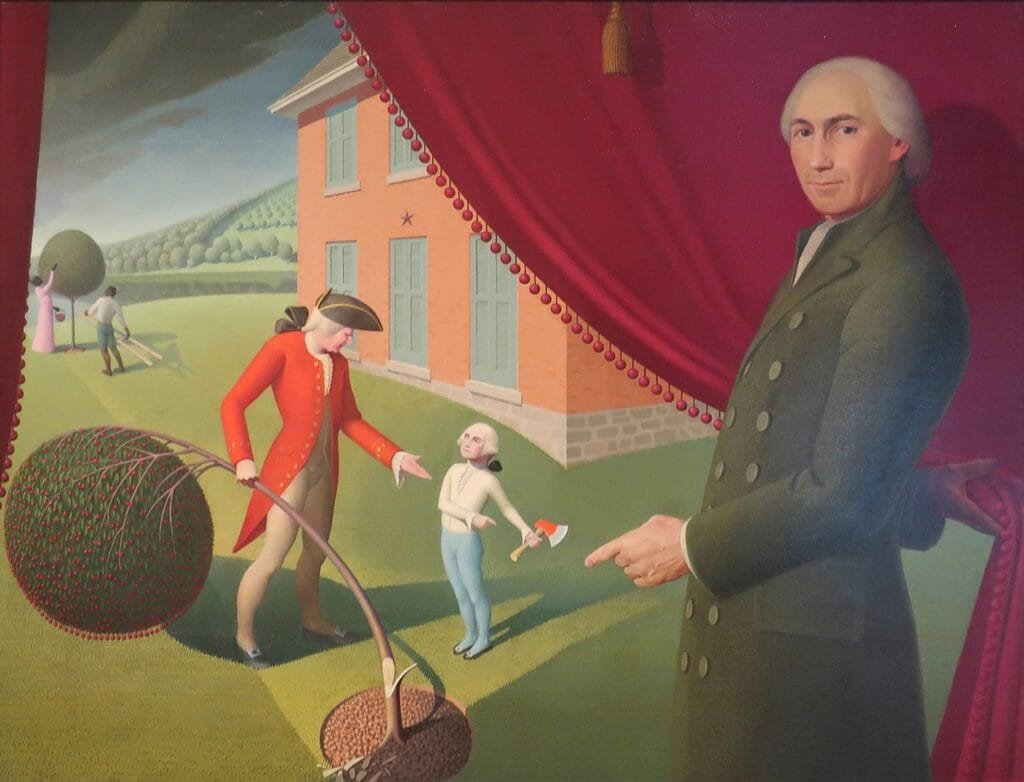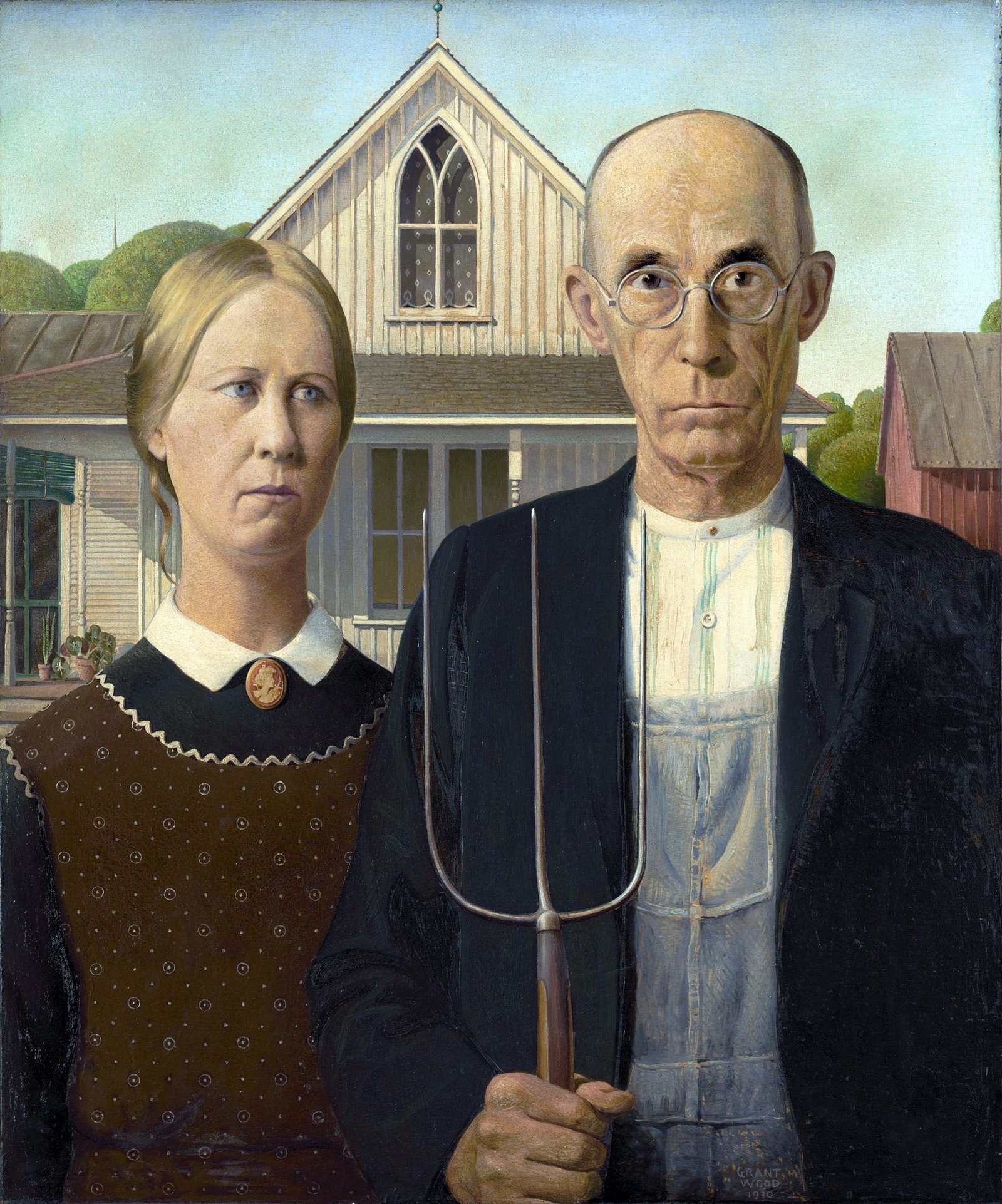Grant Wood (1891-1942) was an American painter and a leading figure in the American Regionalist art movement. He is best known for his iconic painting, “American Gothic,” which has become a symbol of rural America and American art in general. Wood captured the essence of American life during the early 20th century, often with a bit of humor and a deep appreciation for the people and landscapes of his native state of Iowa.

“All the good ideas I ever had came to me while I was milking a cow.”
-Grant Wood
Early Life and Influences
Grant Wood was born on February 12, 1891 on a farm near Anamosa, Iowa. Growing up, Grant Wood was surrounded by the rural landscape that would later become a central theme in his art. Wood became interested in art while he was still in elementary school and he showed an early talent for art.
In 1901, Wood’s father died and his mother moved the family away from the countryside to Cedar Rapids, Iowa. Soon afterwards, Wood began working as an apprentice in a local metal shop to help support his family. Wood continued to nurture his art skills throughout high school, designing sets for plays and creating illustrations for the student newspaper until graduation. In 1910, Grant Wood enrolled in the Minneapolis School of Design, Handicraft, and Normal Art, where he studied metalworking and design.
In addition to his studies at the Minneapolis School of Design, Wood studied life drawing at the University of Iowa before moving to Chicago in 1913 to attend the Art Institute of Chicago. While living in Chicago, Wood worked as a designer for a silversmith shop and made a failed attempt at starting his own jewelry design business.
In 1916, Wood’s mother fell ill so he left Chicago and returned to Cedar Rapids. During this time, Wood built a cottage and then a larger house with a friend so that his family could live together. Near the end of World War I, Grant Wood joined the army where he designed camouflage scenes. He returned to Cedar Rapids in 1916. While in Cedar Rapids, Wood worked as a school teacher to help support his family. He continued to work on his art during this time, even exhibiting several of his paintings at a local department store.
In 1923, Grant Wood managed to travel to Paris to study at the Académie Julian, where he became heavily inspired by the Impressionists and thier depictions of the countryside. In 1928, while in Germany, Wood became interested in the revived realism and stylized figures inspired by Jan va Eyck and Hans Memling. This experience had a profound impact on Wood’s development as an artist, and he began to develop his signature style of detailed realism.
The Rise of Regionalism
Grant Wood returned to Iowa and began to focus on painting the people and places of the Midwest. Abandoning his earlier Impressionistic leanings, Wood’s work began to have a more realistic style. Wood, along with American artists Thomas Hart Benton and John Steuart Curry, was interested in depicting the unique character of American culture. Together, these artists formed the Regionalist movement, which celebrated the rural Midwest and its values of hard work, self-reliance, and community.
The American Regionalism art movement focused on creating honest depictions of rural life in the United States. Regionalist art was realist and often depicted scenes from the American Midwest, American folklore or the Great Depression. Through its subject matter, we can see the roots of Regionalism in other American art movements like the Hudson River School (known for romantic landscape paintings). Ultimately, Regionalist art promoted resiliency and attempted to create a distinctly American art.
‘American Gothic’
One of Grant Wood’s first paintings after his style-altering trip to Germany was also his most famous: American Gothic. Painted in 1930, the painting shows a stern-faced farmer and a woman (assumed to be his wife or daughter) standing in front of a modest, white farmhouse. The man, who was modeled after Wood’s dentist, is holding a pitchfork. The woman, who was modeled after Wood’s sister, is looking to the side. Between the two people’s heads we get a glimpse of one of the home’s decorative gothic windows. In the background of the image, we can see the tip of a church steeple and a red barn.

This painting created more questions than answers. Was the couple husband and wife? Why do they look miserable? Did the work praise the Midwest or poke fun at it? When the work debuted at the Art Institute of Chicago in 1930, it generated a ton of interest and made Wood famous nationwide, almost overnight. American Gothic was a critical and commerical success and has since become one of the most recognizable pieces of American art in history.
At times, the painting is interpreted as parody. However, Grant Wood said that American Gothic is not meant to be a caricature of Midwesterners and is meant to appreciate Iowa and its’ people. He also said that he painted the farmer standing next to his daughter (not his wife) because he imagined they were the type of people that would live in that little white farmhouse. While the work has been interpreted in many ways over the years, it is generally seen as a representation of the American spirit.
Life After ‘American Gothic’
While American Gothic is by far Grant Wood’s most famous work, his career consisted of a range of art: Arts and Crafts decorative objects, Impressionist oil paintings, murals and book illustrations. After American Gothic, Wood became a leader of the American Regionalist movement. Other works representative of the Regionalist movement include Woman with Plants (1929), Victorian Survival (1931), Appraisal (1931), Daughters of Revolution (1932), Midnight Ride of Paul Revere (1931) and Dinner for Threshers (1934).
Riding the wave of his newfound fame, Grant Wood co-founded the Stone City Colony and Art School in 1932. His goal was to spread the tenets of Regionalism to aspiring artists. Two years later, seeking a more impactful platform, he left to take a position in the art department of the University of Iowa. During this same year, he was also named director fo the Public Works of Art Project in Iowa and featured in Time magazine.

Often described as a “shy bachelor”, Wood suddenly married singer Sara Maxon in 1935. The marriage was tumultuous. He only completed one painting in the following three years. He and his wife divorced in 1939, he was in trouble with the IRS for tax evasion, his mother died and his lack of work had started whispers that he was past his prime. Wood’s art style began to fall out of favor as abstract art began its’ rise in America.
Grant Wood also found himself at odds with some of the administrators in the art department of the University of Iowa. A new department chair, Lester Longman, preferred avant-garde modernism and often clashed with Wood on teaching style and subject matter. Longman even went as far as to attempt to publicly discredit Wood by criticizing his paintings at conference lectures.
Eventually, the university removed Wood from Longman’s supervision and Wood’s productivity began to return. Celebrities like Cole Porter, Alexander Woolcott and Katherine Hepburn all acquired Grant Wood’s work. Unfortunately, Wood was diagnosed with pancreatic cancer in October of 1941, just as he had began to bounce back. Grant Wood died a few months later, a day shy of his fifty-first birthday. He was buried on his family’s plot in Anamosa, Iowa.
| Year | Event/Work | Significance |
|---|---|---|
| 1891 | Born in Anamosa, Iowa | Beginnings in rural Iowa that would shape his artistic vision |
| 1901 | Family moves to Cedar Rapids | Early exposure to a more urban environment. |
| 1910 | Attends Minneapolis School of Design | Formal training in art begins. |
| 1923 | Travels to Paris | Exposure to European art broadens his perspective. |
| 1930 | Paints American Gothic | Achieves national recognition. |
| 1930 | Paints Stone City, Iowa | Furthers develops his Regionalist approach to landscape. |
| 1932 | Paints Daughter of Revolution | Demonstrates satirical wit & social commentary. |
| 1939 | Paints Parson Weems’ Fable | Explores American history and mythology. |
| 1942 | Dies in Iowa City, Iowa | Leaves behind a lasting legacy in American art. |
Grant Wood’s Legacy
Grant Wood’s legacy extends far beyond his iconic American Gothic. He is a pivotal figure in American art history for his role in shaping and popularizing Regionalism. This movement, which emphasized local subject matter and a rejection of European modernism, resonated with a nation grappling with the Great Depression and seeking a renewed sense of identity. Wood’s paintings, with their meticulous detail and stylized realism, captured the essence of the rural Midwest, offering a vision of America grounded in hard work, community values, and a connection to the land.
While American Gothic remains his most recognizable work, Wood’s influence is evident in the broader shift towards appreciating and depicting regional experiences in American art.
He inspired generations of artists to find beauty and meaning in their own locales, fostering a sense of pride in the unique character of different parts of the country. His work continues to be celebrated in exhibitions and publications, and his paintings remain powerful symbols of American identity, reminding us of the enduring connection between art, place, and cultural heritage.Artists like Thomas Hart Benton and John Steuart Curry were also key figures in the Regionalist movement, but Wood’s distinctive style and iconic imagery set him apart.He helped to shape a distinctly American artistic vocabulary, and his influence can still be seen in contemporary artists who draw inspiration from local traditions and explore themes of rural life and identity.
Article Sources:
- American Regionalism Movement Overview | The Art Story
- Grant Wood – NGA.gov
- Grant Wood – Wikipedia
- Grant Wood Paintings, Bio, Ideas | The Art Story
- Grant Wood – Paintings, Artwoprks & Regionalism – Biography.com
- Iowa Art Experts Set Out to Catalogue Grant Wood’s Prolific Career

Leave a Reply